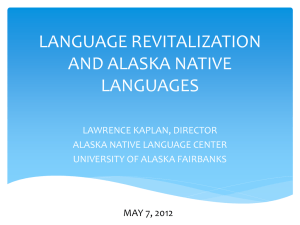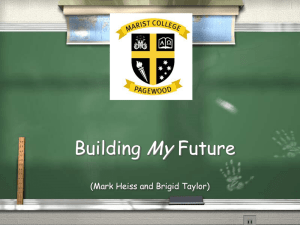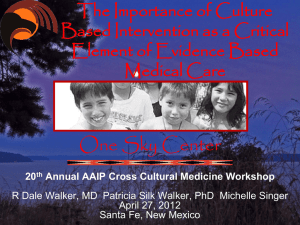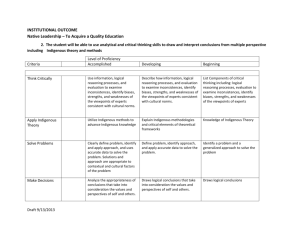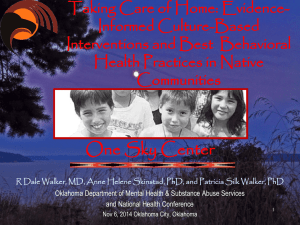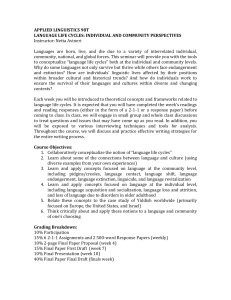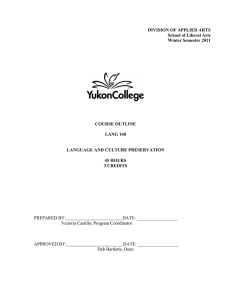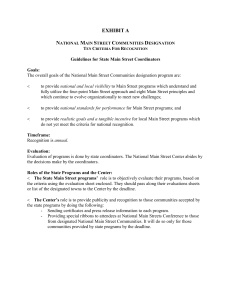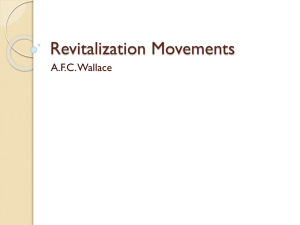overview
advertisement
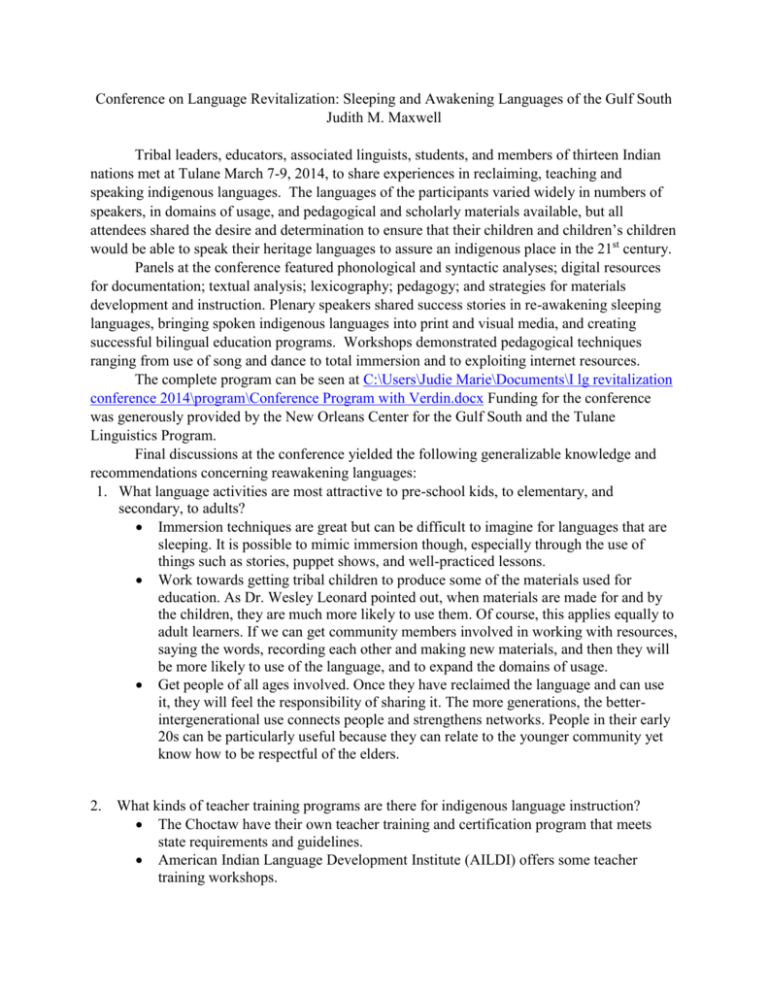
Conference on Language Revitalization: Sleeping and Awakening Languages of the Gulf South Judith M. Maxwell Tribal leaders, educators, associated linguists, students, and members of thirteen Indian nations met at Tulane March 7-9, 2014, to share experiences in reclaiming, teaching and speaking indigenous languages. The languages of the participants varied widely in numbers of speakers, in domains of usage, and pedagogical and scholarly materials available, but all attendees shared the desire and determination to ensure that their children and children’s children would be able to speak their heritage languages to assure an indigenous place in the 21st century. Panels at the conference featured phonological and syntactic analyses; digital resources for documentation; textual analysis; lexicography; pedagogy; and strategies for materials development and instruction. Plenary speakers shared success stories in re-awakening sleeping languages, bringing spoken indigenous languages into print and visual media, and creating successful bilingual education programs. Workshops demonstrated pedagogical techniques ranging from use of song and dance to total immersion and to exploiting internet resources. The complete program can be seen at C:\Users\Judie Marie\Documents\I lg revitalization conference 2014\program\Conference Program with Verdin.docx Funding for the conference was generously provided by the New Orleans Center for the Gulf South and the Tulane Linguistics Program. Final discussions at the conference yielded the following generalizable knowledge and recommendations concerning reawakening languages: 1. What language activities are most attractive to pre-school kids, to elementary, and secondary, to adults? Immersion techniques are great but can be difficult to imagine for languages that are sleeping. It is possible to mimic immersion though, especially through the use of things such as stories, puppet shows, and well-practiced lessons. Work towards getting tribal children to produce some of the materials used for education. As Dr. Wesley Leonard pointed out, when materials are made for and by the children, they are much more likely to use them. Of course, this applies equally to adult learners. If we can get community members involved in working with resources, saying the words, recording each other and making new materials, and then they will be more likely to use of the language, and to expand the domains of usage. Get people of all ages involved. Once they have reclaimed the language and can use it, they will feel the responsibility of sharing it. The more generations, the betterintergenerational use connects people and strengthens networks. People in their early 20s can be particularly useful because they can relate to the younger community yet know how to be respectful of the elders. 2. What kinds of teacher training programs are there for indigenous language instruction? The Choctaw have their own teacher training and certification program that meets state requirements and guidelines. American Indian Language Development Institute (AILDI) offers some teacher training workshops. Indigenous Languages Institute runs teacher workshops on early childhood immersion and Head Start and includes curriculum development, and language planning. 3. Are there any transferable techniques from one successful program to others? Putting languages in official and public settings is an important early step. Prayer is a particularly potent way of making the language visible and audible. Work towards getting tribal children to produce some of the materials used for education. The Myaamia language revitalization efforts have shown the efficacy of having peers, children and adults, create their learning aids, implement them, and then spread the use of the language. Recording each other speak is an effective and fun teaching tool. 4. Can Breath of Life type workshops be run by tribes themselves? We need to make a concerted effort to transfer the ownerships of conferences and workshops like these from universities to tribes so that tribes are asking academics onto their space and owning the process. Having tribes host these kinds of conferences would also be beneficial in demonstrating techniques and the use of space in a way that is not possible in the university setting. It is important to bring AILDI and CoLang type events to the reservation to reach elders and families who cannot travel long distances. This would help the community get involved and take ownership of the revitalization project. It would be important to create a distraction-free environment for such meetings though, so having adequate child care and other services is important. 5. What kinds of tools or (free) resources are available online for sharing of language information, lessons, activities? Are there any that are especially fun, useful? Webpages of CoLang, Breath of Life, AILDI, Cails Nativeweb.org has a database of resources Administration for Native Americans has links on their webpage Native-languages.org ww-bcf.usc.edu/~cmmr/Native_American.html Library.lakeheadu.ca/?pg=506 6. What kinds of non-language activities foster an environment for language learning? Language is in everything that humans do, so we can take any task and use it to practice language. In this sense, the world is ours to use. The Miami YouTube video of teeth brushing is a good example. Don’t forget to work on cultural revitalization as well as language revitalization. Language has to refer to culture, so make sure to have cultural activities as well. Some suggestions include stickball and other indigenous activities. Also, as per Dr. Leonard’s experience with the Myaamia, programs should highlight core cultural values of what it means to be X tribe but also acknowledge that people are multicultural. 7. How to facilitate the transition from vague community support (i.e. a positive attitude toward the language) to active involvement in language learning, teaching, and use? Get people of all ages involved. Once they have some control of the language, they will feel the responsibility of sharing it. The more different age groups, backgrounds, interests represented, the easier it is to draw people in and maintain interest. Young people in their late teens and early twenties make enthusiastic language models and mentors. 8. Can we establish a network to continue sharing experiences, expertise, and knowledgebases? Work on using social media like Facebook and Twitter to stay connected. Using Indigenous Pen Pals in indigenous languages could also be helpful. Continuing to network after conferences is critical for energy levels and dedication to the projects we work on. We could potentially create a regional network with a homebase website where we could host bi-monthly webinars to keep people energized, focused, and motivated. That would also help develop best practices and useful techniques. Alternatively, we could try to connect Pow-wow activities to language revitalization and offer a one-day gathering before or after a Pow-wow.
